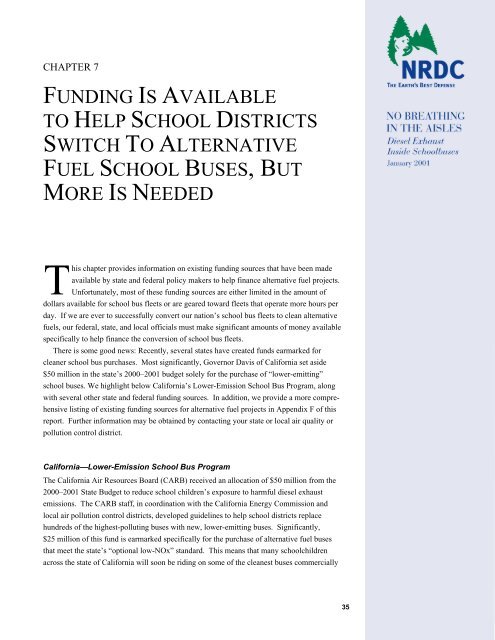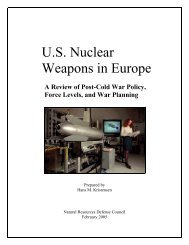NRDC: No Breathing in the Aisles: Diesel Exhaust Inside School ...
NRDC: No Breathing in the Aisles: Diesel Exhaust Inside School ...
NRDC: No Breathing in the Aisles: Diesel Exhaust Inside School ...
You also want an ePaper? Increase the reach of your titles
YUMPU automatically turns print PDFs into web optimized ePapers that Google loves.
CHAPTER 7<br />
FUNDING IS AVAILABLE<br />
TO HELP SCHOOL DISTRICTS<br />
SWITCH TO ALTERNATIVE<br />
FUEL SCHOOL BUSES, BUT<br />
MORE IS NEEDED<br />
This chapter provides <strong>in</strong>formation on exist<strong>in</strong>g fund<strong>in</strong>g sources that have been made<br />
available by state and federal policy makers to help f<strong>in</strong>ance alternative fuel projects.<br />
Unfortunately, most of <strong>the</strong>se fund<strong>in</strong>g sources are ei<strong>the</strong>r limited <strong>in</strong> <strong>the</strong> amount of<br />
dollars available for school bus fleets or are geared toward fleets that operate more hours per<br />
day. If we are ever to successfully convert our nation’s school bus fleets to clean alternative<br />
fuels, our federal, state, and local officials must make significant amounts of money available<br />
specifically to help f<strong>in</strong>ance <strong>the</strong> conversion of school bus fleets.<br />
There is some good news: Recently, several states have created funds earmarked for<br />
cleaner school bus purchases. Most significantly, Governor Davis of California set aside<br />
$50 million <strong>in</strong> <strong>the</strong> state’s 2000–2001 budget solely for <strong>the</strong> purchase of “lower-emitt<strong>in</strong>g”<br />
school buses. We highlight below California’s Lower-Emission <strong>School</strong> Bus Program, along<br />
with several o<strong>the</strong>r state and federal fund<strong>in</strong>g sources. In addition, we provide a more comprehensive<br />
list<strong>in</strong>g of exist<strong>in</strong>g fund<strong>in</strong>g sources for alternative fuel projects <strong>in</strong> Appendix F of this<br />
report. Fur<strong>the</strong>r <strong>in</strong>formation may be obta<strong>in</strong>ed by contact<strong>in</strong>g your state or local air quality or<br />
pollution control district.<br />
California—Lower-Emission <strong>School</strong> Bus Program<br />
The California Air Resources Board (CARB) received an allocation of $50 million from <strong>the</strong><br />
2000–2001 State Budget to reduce school children’s exposure to harmful diesel exhaust<br />
emissions. The CARB staff, <strong>in</strong> coord<strong>in</strong>ation with <strong>the</strong> California Energy Commission and<br />
local air pollution control districts, developed guidel<strong>in</strong>es to help school districts replace<br />
hundreds of <strong>the</strong> highest-pollut<strong>in</strong>g buses with new, lower-emitt<strong>in</strong>g buses. Significantly,<br />
$25 million of this fund is earmarked specifically for <strong>the</strong> purchase of alternative fuel buses<br />
that meet <strong>the</strong> state’s “optional low-NOx” standard. This means that many schoolchildren<br />
across <strong>the</strong> state of California will soon be rid<strong>in</strong>g on some of <strong>the</strong> cleanest buses commercially<br />
35
















